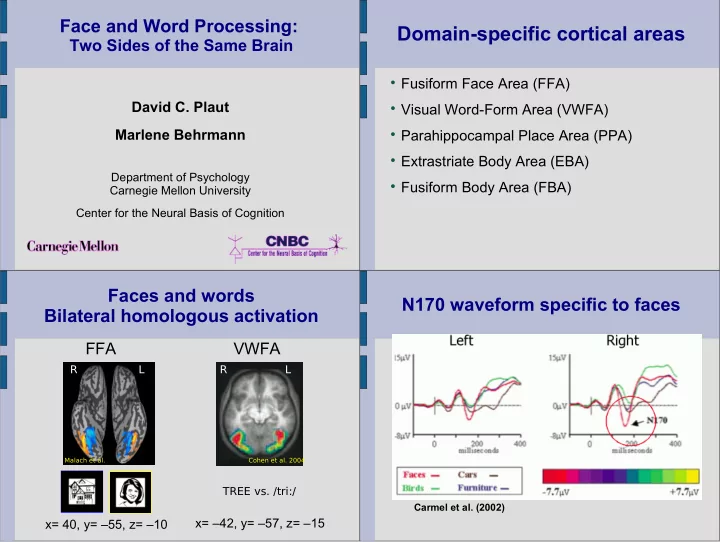

Face and Word Processing: Domain-specific cortical areas Two Sides of the Same Brain Fusiform Face Area (FFA) Visual Word-Form Area (VWFA) David C. Plaut Parahippocampal Place Area (PPA) Marlene Behrmann Extrastriate Body Area (EBA) Department of Psychology Fusiform Body Area (FBA) Carnegie Mellon University Center for the Neural Basis of Cognition Faces and words N170 waveform specific to faces Bilateral homologous activation FFA VWFA R L R L Malach et al. Cohen et al. 2004 TREE vs. /tri:/ Carmel et al. (2002) x= –42, y= –57, z= –15 x= 40, y= –55, z= –10
Faces and words: ERP N170 waveform for letter strings L R L R L R Bentin et al. (1999) Rossion et al. (2003) Maturation of FFA Lesions to FFA Prosopagnosia − Visual recognition much poorer for faces vs. other objects − Can be bilateral but right lesion suffices − Rely on other cues for recognition R R R Scherf et al. (2007)
FFA adjacent to central visual information Lesions to VWFA Levy et al. (2001), Malach et al. (2002) Pure alexia − Impairment in word recognition in premorbidly literate adults − Left occipitotemporal lesion − No general language impairment − Rely on sequential “letter-by-letter” strategy Faces, words and eccentricity Hemispheric model Hasson et al. (2003)
Faces Houses Words
Scale variation X-Y coordinates Polar coordinates central peripheral central peripheral Acquisition Receptive/ projective fields Central vision
Lesioning Receptive/ projective fields method For each horizontal Peripheral vision position (central to peripheral) in each hemisphere, remove three adjacent columns of intermediate (fusiform) units Measure recognition performance on faces and houses (across all scales)
Predictions Domain generality Domain generality Pure alexia − Ventral temporal-occipital cortex involved in any fine- grained visual discrimination Bilateral participation − Unilateral lesions impact both faces and words Competition for representation − Degree of face and word specialization related within individuals Same-different matching Linear effect of visual complexity Reaction Time (ms) + Visual Complexity
Bilateral participation Words: Lexical decision Predicted extent of impairment Alexia Controls Prosop. Words RT Faces Face discrimination (errors): Competition for representation Controls < Alexia < Prosop. Match-to-sample task: words or faces % Errors within-field between-field
Left-field advantage for faces Right-field advantage for words Individual distribution Correlation Compare magnitudes of within-field advantage for faces (left field) vs. words (right field)
Conclusions Distributed cortical network for faces and words − Different representations, similar computations Reliance on high visual acuity − Fine-grained discriminations Topographic constraints on learning − Bias for local connectivity Graded functional specialization − Both within and between hemispheres
Recommend
More recommend